Jamnagar Birding
- With JungleHike Tours (Avinash Bhagat)
- 26 to 29 Dec, 2019
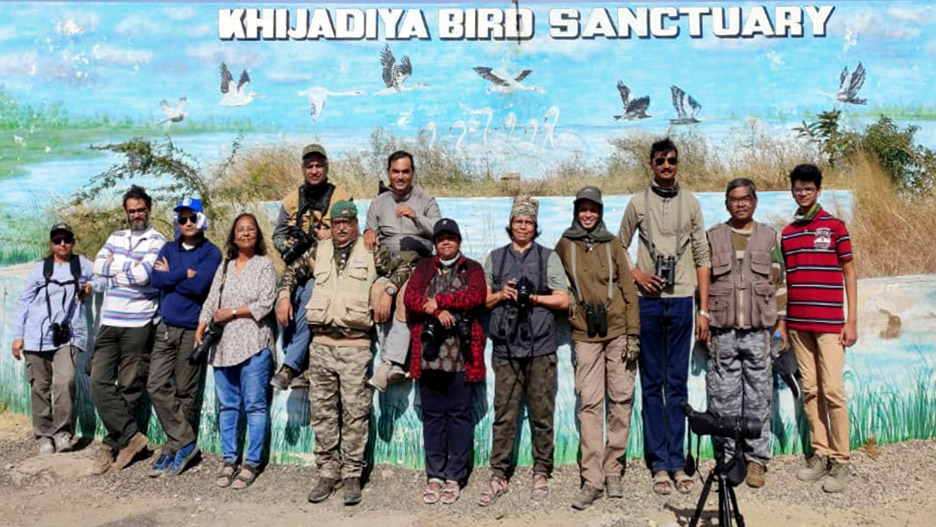
Team at Khijadiya
Highlights:
- Unexpected sighting of a huge flock of Indian Skimmers
- Rare sighting of Black-necked Grebe
- Fascinating Marine Life at Narara
- Adventure for Oystercatchers
- Close proximity of ducks at Lakhota Lake
Background
The birding season in India typically starts with the arrival of the migratory species (typically from October end). And the planning for these 3-4 months (Nov to Feb) starts much earlier.
When JungleHike announced their trip to Jamnagar for birding, I was not so sure about the location. But knowing Avinash, I was immediately ready to take the trip. Somewhere in early September, the train bookings were also done and we were all set for last week of December.
As the dates were approaching, I started gathering some more background about the location. Went to the eBird website to check the possible bird species that we could see. Crab Plovers, Great-crested Grebe and other waders seem to be the specialties of Jamnagar. A week prior to that, I also had a photography trip to Little Rann of Kutch and temperatures in Gujarat seemed to be lower compared to Mumbai. Expected even Jamnagar to be on similar lines.
As most of the birding was expected to be done on foot (travelling in vehicles to different places, and then get down for photography), carrying tripod was must. Avinash instructed us to carry good floaters as we were to make a round to the Marine National Park as well (we were expected to walk in ankle-deep waters and hence floaters were preferred).
The excitement began as the day approached. Our travel this time was from Bandra terminus on the X’mas day. Being Holiday, there was no traffic and we reached the station well in time. We were a group of 13 birders (including Clara & Avinash from JungleHike) and all except 1 were boarding from Bandra.
Train Journey and Day 1 (26-Dec)
The train journey was very boring. Started at 5pm and the train finally crawled into Jamnagar at 11am the next day. We were late by about 2 hours and that meant reduced time for morning birding.
Our vehicles were waiting outside the station and we quickly loaded all our luggage in it. Avinash had a quick word with local guide and planned for the day’s activities.
We first headed for breakfast. It was a roadside eatery having with a typical Gujarati menu (which most of us enjoyed anyway). Quick snacks of Dhokla, poori-bhaji, khaman, paratha and a nice tea energized all of us for the remainder of the day. From there we went to our hotel, kept our luggage in the available rooms (other rooms were to be available only by evening and we were anyway planning to go birding till that) and moved on.
Luckily most of these places were near-by and the road journey was mostly 10-20 minutes.
Our first birding spot was “Bedi Port”. It was past mid-day and the light was too harsh but all of us were enthusiastic to see whatever was available. Apparently, this was the place where a “Dowitcher” was sighted couple of seasons back and in the memory, one small restaurant there was named as “Didar-e-Dowitcher”.
Immediately on display were the “Western Reef Herons, Grey-Plovers and lot of sea gulls”. Avinash was ready with his binocs and boy, he seemed to be really excited about something. Apparently, behind the flock of gulls, he had sighted Indian Skimmers. That obviously made our day, as it was “Lifer” for many of us. (For people unfamiliar with this terminology, a “lifer” in birding parlance means, a bird-specie that is being seen for the first time by the birder). And they were really in big numbers. Avinash mentioned that he has not seen such big numbers even in Chambal (where people specially go to see the skimmers).
One little problem was the skimmers were really far-off from us. We could only see it from the spotting scope (and off-course thru cameras of Pallavi and Milind, as they were carrying the Nikon P1000 with its unbelievable zoom). Plus the Sun was behind them, making photography difficult anyway.
Chetan (our local guide) suggested that we can approach that area from other side where the light won’t be against us but till then, we concentrated on the birds that were in front of us. There were greater flamingos, some terns and Grey herons too. Just then we even sighted the “Eurasian Curlew”. With its really long beak, it cannot be missed even from distance. One lone pied-kingfisher was then seen hovering in the near-by skies. It is famous for scouting the waters by hovering above it and then make a dash once a fish is located.
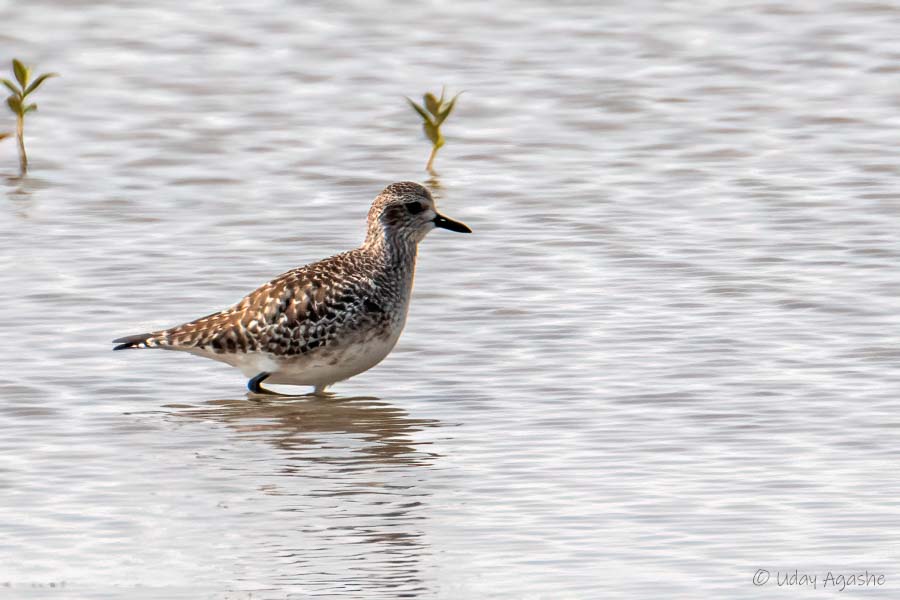
Grey Plover
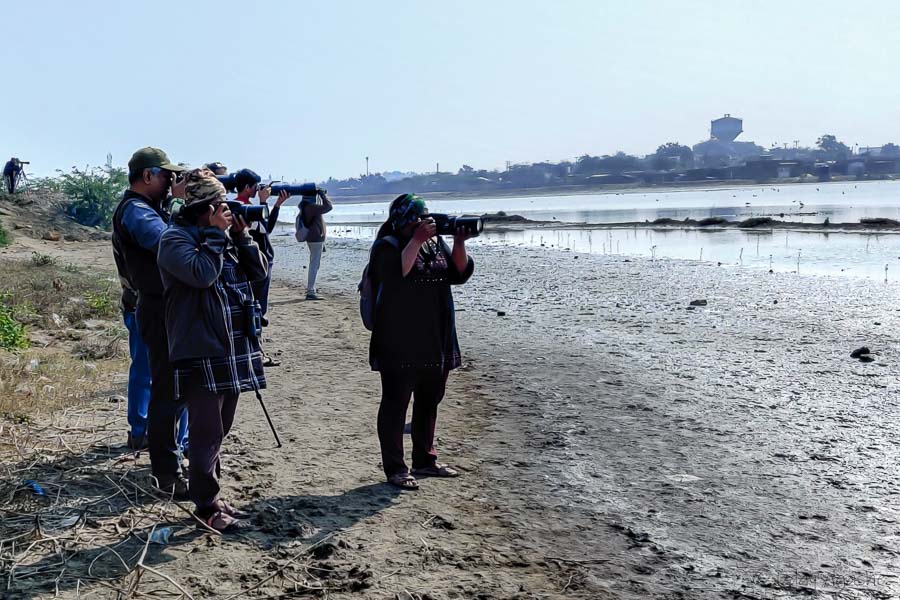
Group capturing the Birds
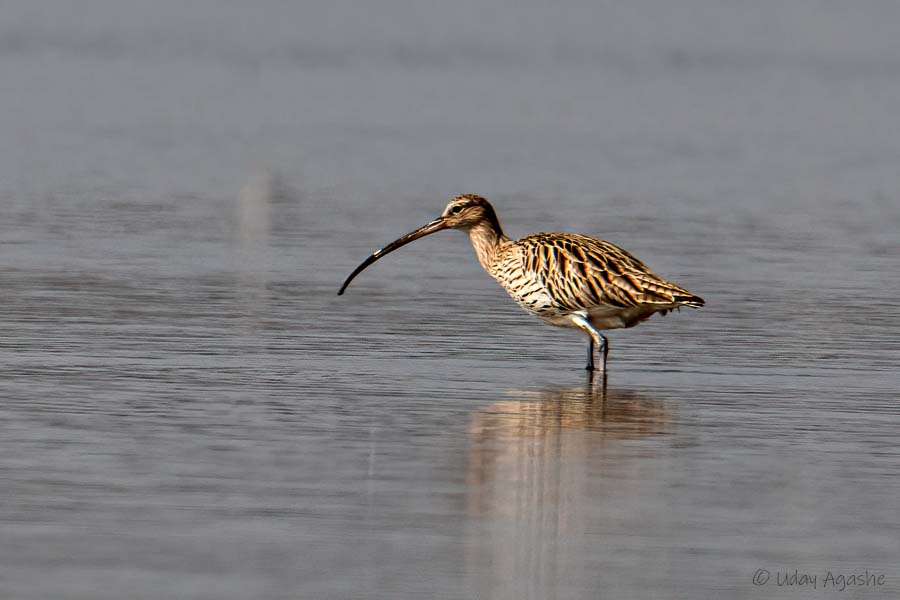
Eurasian Curlew
We stayed there for about half hour and then decided to approach the skimmer area. Luckily there was a drivable road leading in that direction. As we were discussing about going there, the skimmers as well as gulls suddenly decided to fly but fortunately, they all circled back in next 5 minutes to the same area. Had they decided to fly away, we would have missed a big opportunity.
As we were heading to that part of the port, we had to stop on the way. One Reef-egret was very close to the road and I just could not resist that opportunity. I quickly got down from the vehicle (others decided to raise their cameras from the vehicle itself). The egret did not disappoint me at all.
As we moved along, we even saw the greater flamingos from a very close distance. So we had to make another stop there too.
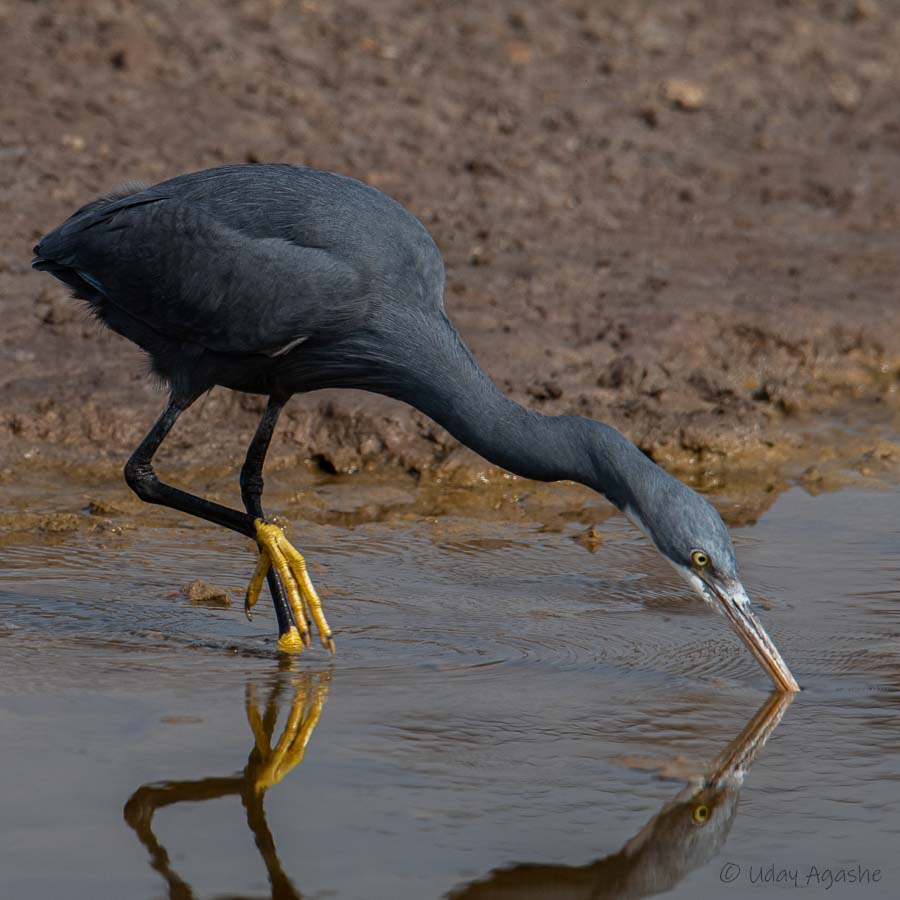
Western Reef Egret
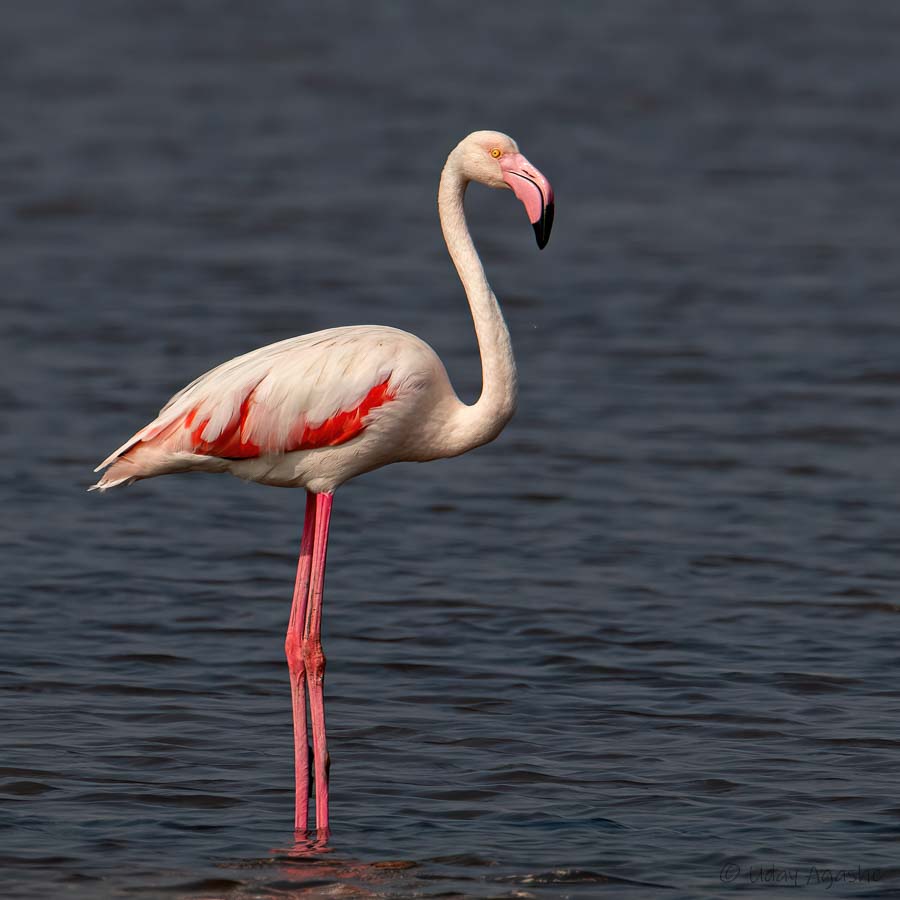
Greater Flamingo
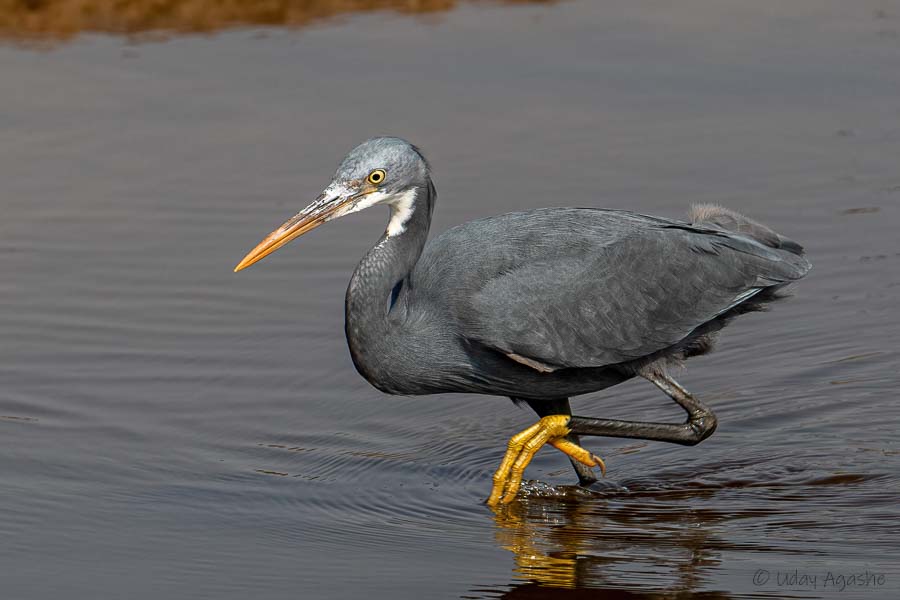
Western Reef Egret
We went by vehicles to the farthest point and then had to walk in the sand (and dried mud). We walked as much as we could and stopped only when the soil below was wet. Walk any further, and there was danger of getting stuck in the mud. Avinash still attempted a few steps bur Chetan bhai warned us against it.
The skimmers were still far but that was the best possible we could reach to.
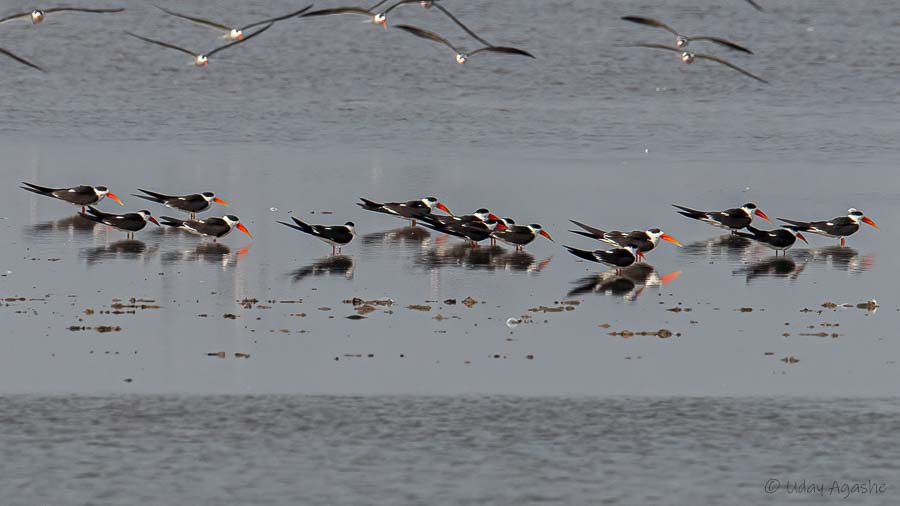
Indian Skimmers
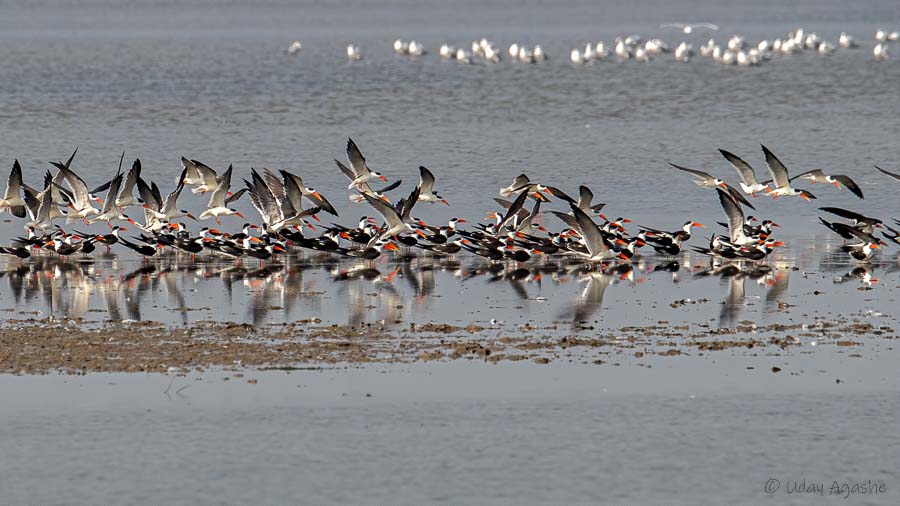
Indian Skimmers
On the way back, we once again stopped for Flamingos. There were a few Ruffs also seen close by, along with Redshank and few other waders.
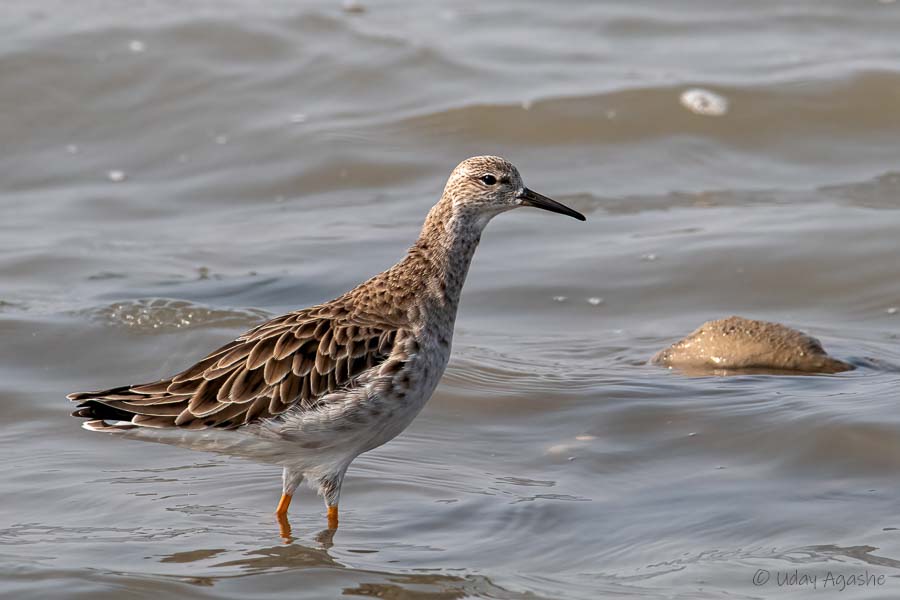
Ruff
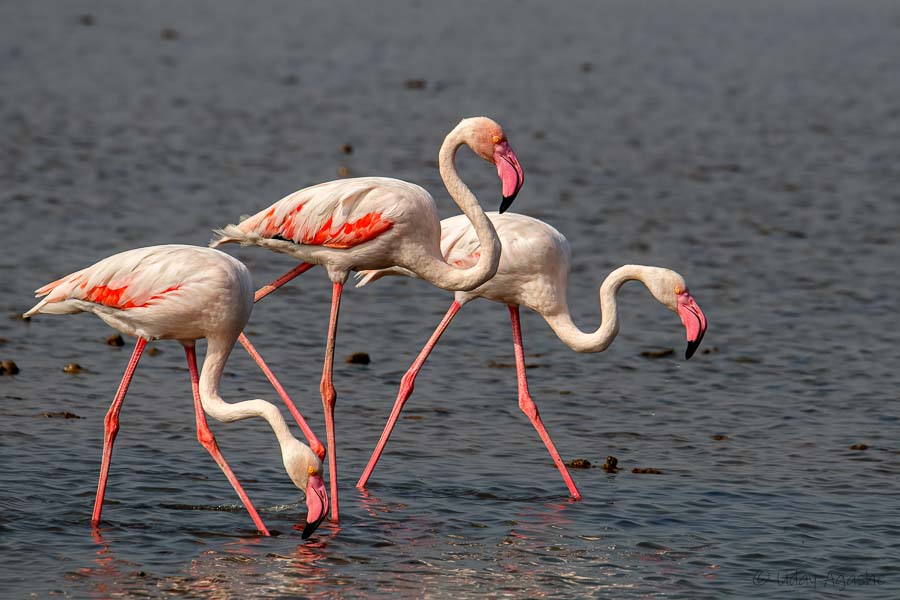
Greater Flamingos
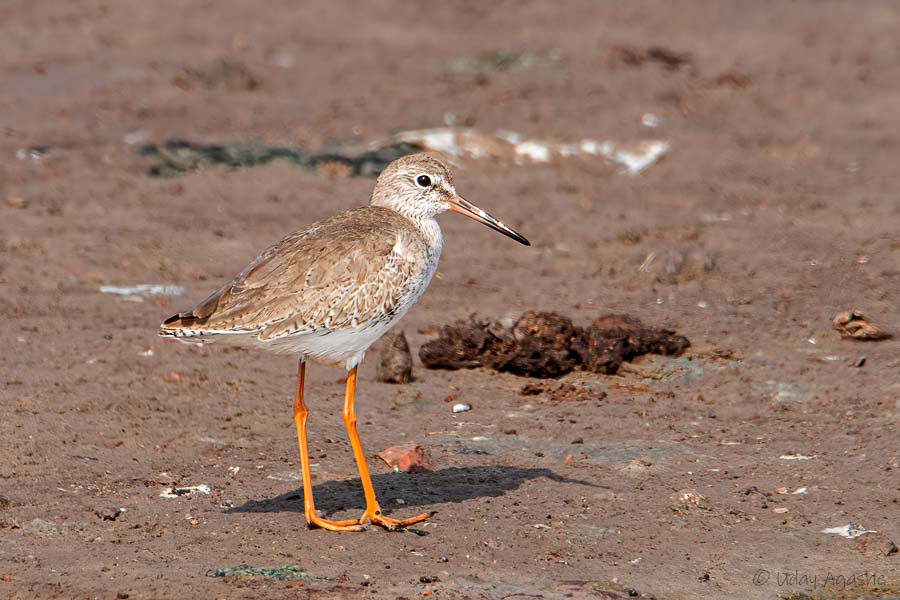
Common Redshank
By now it was 2:30pm, but before taking the lunch break (delayed off-course), we went to another nearby spot (around the Bedi bandar area itself). On the way, we saw a nice pair of Brahminy kites as they decided to perch on a cement stump. Obviously, we all got down from vehicles and put our tripods on. At far end of the muddy area, there was a Whimbrel seen foraging but it was too far for any meaningful photograph. As we were busy clicking the kites, one of them suddenly took flight and went in the direction of the gulls near-by. Within that fraction of a second, all the gulls got alerted and started flying but the kite was probably not in hunting mood. It flew away and the gulls settled back.
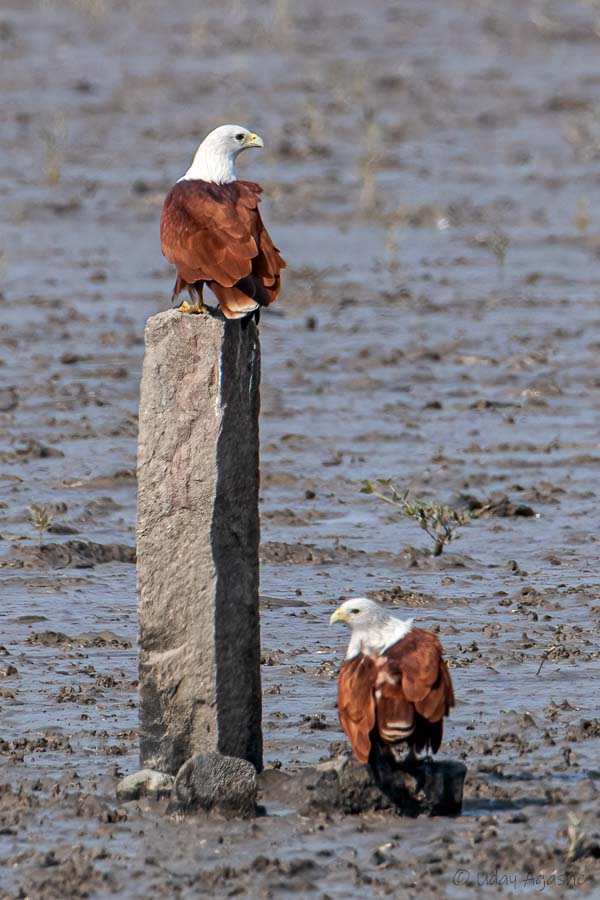
Brahminy Kite pair
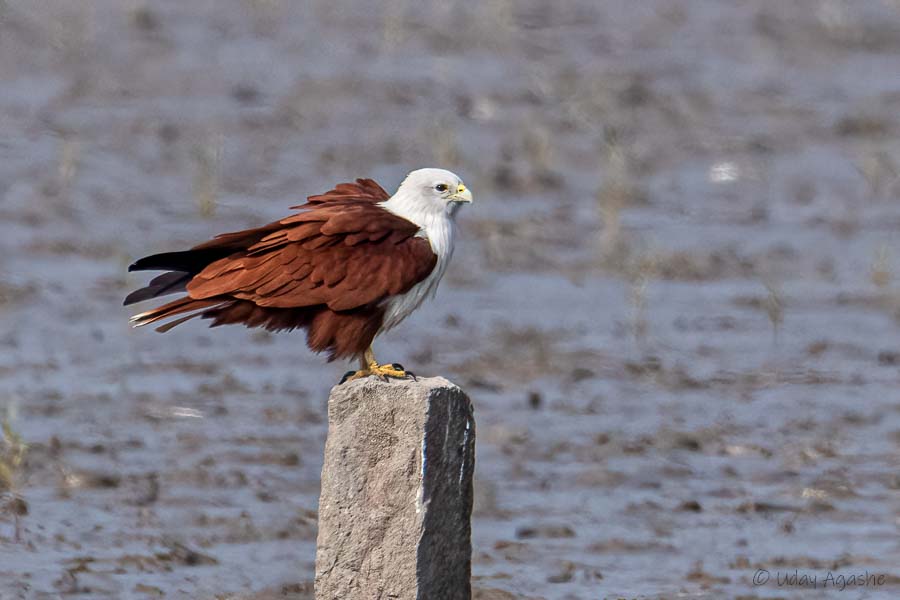
Kite preparing to fly
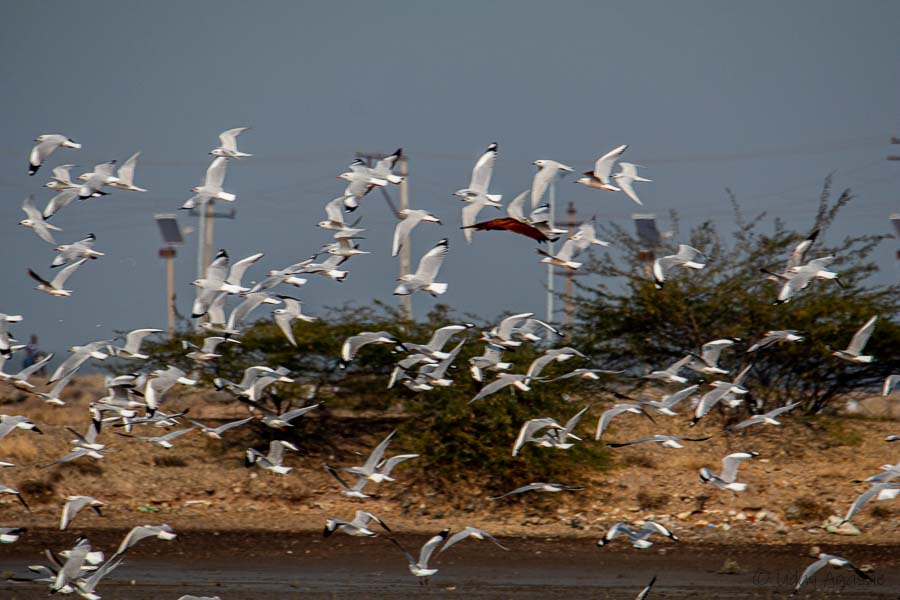
Scare caused by the Predator
As we moved further, there were more birds on display. The gulls were flying all across and some were even seen swimming near-by. Avinash asked to look at those little closely and mentioned that these were the “Slender-billed Gulls”.
As we were about to start back, Avinash asked us to quickly take some more snaps of the larks roaming near-by. He identified them as the “Sand Larks”. Both these were lifers for me (and probably to many other tour members as well).
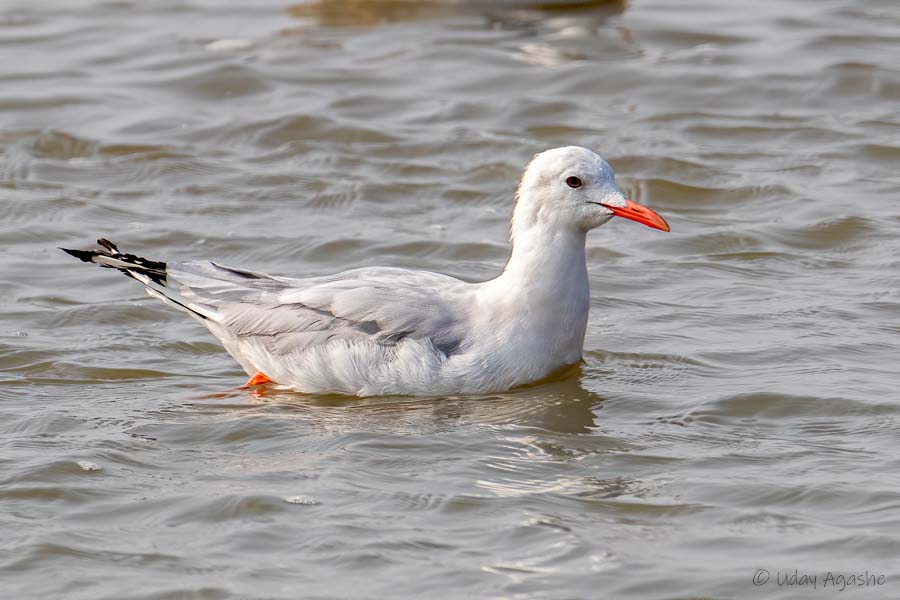
Slender-billed Gull
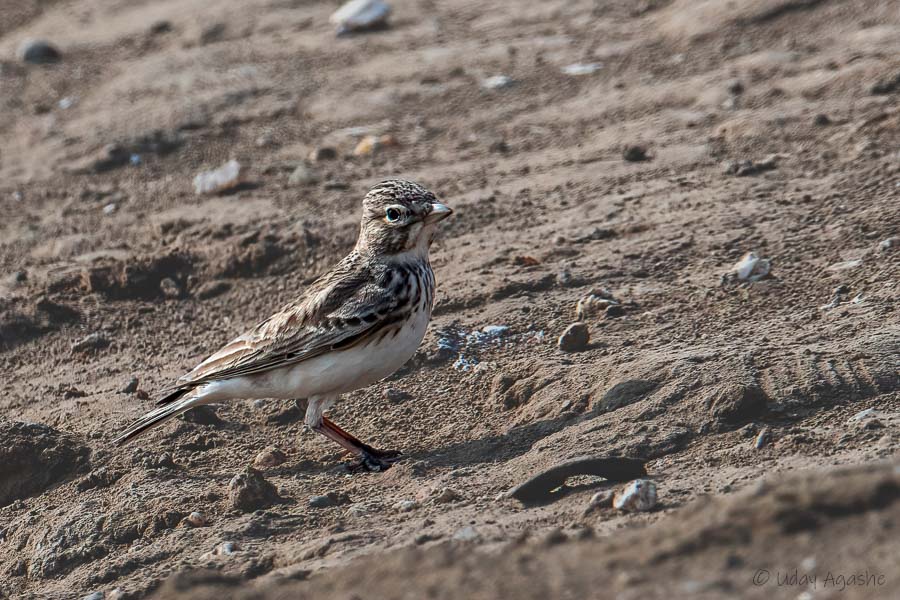
Sand Lark
After lunch, at max we had an hour of light left (for photography), so we went to yet another port (further away from the Bedi port). Here in the fading light, we were lucky to see another rare variety that is Jamnagar special, the “Great Crested Grebe”. Suddenly all of us zoomed our cameras on that single bird which kept going underwater very frequently (as all Grebe species do that), thus allowing only limited opportunities to capture it before it swam far away from us.
In that fading light, we clicked a few more birds and then drove back happily to our hotel rooms.

Little Ringed Plover

Yellow Wagtail

Great Crested Grebe
The day was still not over as we had to get into a small meeting after dinner to discuss over the species we had seen today and also some gyan session with Clara and Avinash. They explained us the habitats in Jamnagar and what can we expect in the next 2 and half days.
Day 2: Khijadiya Bird Sanctuary
Today our plan was to start at 7 (assemble at 6:45 for a quick tea as luckily the tea-stall next to our hotel was a 24-hour one and getting a nice hot tea was not an issue at any hour of the day).
Instead of first going to the Khijadiya sanctuary directly, Avinash took us to an isolated birding spot (not frequented by many and thus less disturbance for birds in the area). Here we were walking on an elevated mud-road (not a well-made road but was wide enough for a tempo or 2 wheelers to ply … basically to access the remote village at the other end). On both sides there were water bodies, muddy patches and some scrub bushes in between.
This area seemed to be full of bird activity but most of them were successfully hiding from us. Here again we saw the Grebe and its nest. We also saw a Black-necked stork guarding its nest. We were walking along, keeping quiet (as much as possible for a group 13) and listening to Avinash/Clara as they kept identifying various birds.
On the way back, Avinash again called out for our attention towards a small sparrow like bird chirping in the nearby bushes. But for his attention, we would have ignored it easily. It turned out to be another lifer for me, the “Graceful Prinia”.
There were many others, the “Bluethroat (gets the name because of the beautiful pattern on its throat)”, the “Isabelline Shrike (nothing to do with any Isabel but that signifies the light buff color of the bird)” and many warblers too.
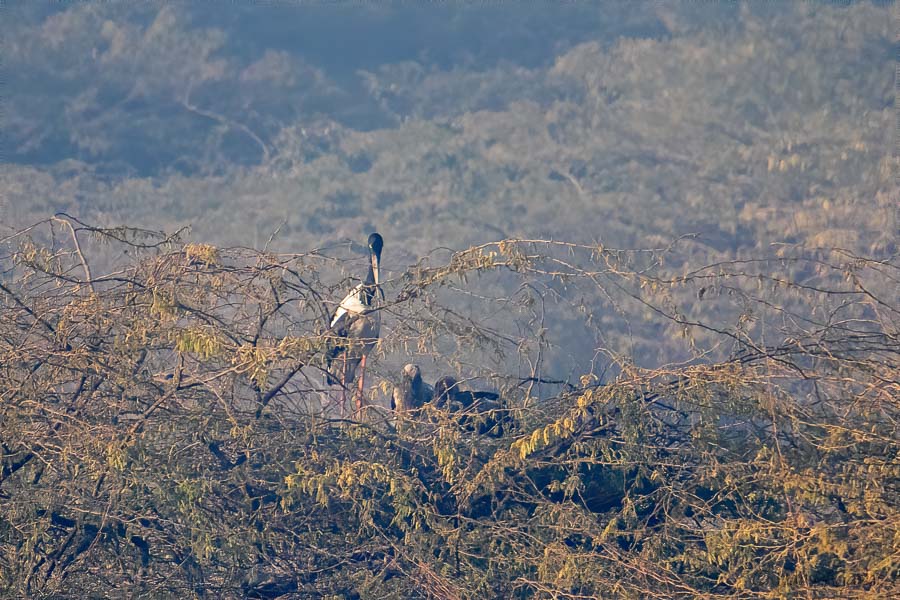
Black-necked Stork with Nest

Black-necked Stork - in flight
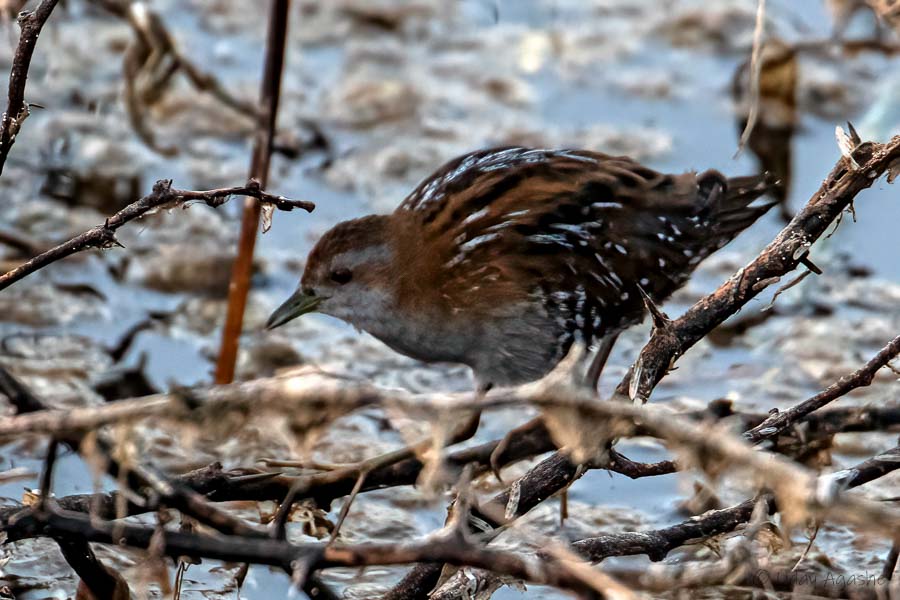
Baillon's Crake

Graceful Prinia
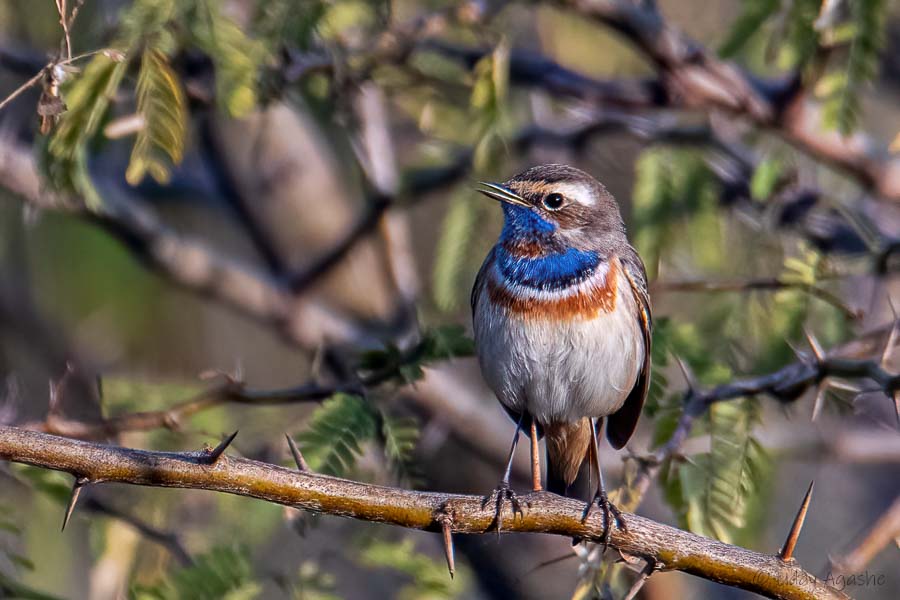
Bluethroat (male)

Isabelline Shrike
This short detour turned out to be very good for us but we had spent a lot of time there.. it was already 10:15 and we had to still reach Khijadia sanctuary.
By the time, we entered the Sanctuary gates, it was 11:30. Our guides had taken this call (of reaching late) because of the increased water level in the park. Because of the excess rains throughout the country, all the lakes/parks this year have lot of water and that means the birds are now spread over larger areas. In fact, the birds can now easily stay in remote (from human interference) areas thereby avoiding human contact.
Because of this, there were not many birds seen in the sanctuary area. That is why Avinash decided to visit other area first and then come to the park.
But the park visit wasn’t that bad. Immediately on entry, we saw a group of “Common Teals (Ducks)” nearby. It was followed by the graceful flight of the “Eurasian Marsh Harrier”. While this was happening on the left-hand side of the path, Avinash pointed to the right side, where a Dalmatian pelican was landing in the waters. Near it, there was a “Common Greenshank” and few other waders too. We could also see “Comb Ducks” & “Flamingos” at some distance away from us.
100 meters further, we came across another “Great Crested Grebe”, it kept floating/swimming in the vicinity and kept all of us engaged for next 15-20 minutes.
But the highlight of the park was the “Indian Paradise Flycatcher”. It was relatively bold bird, flying very close to us and was also seen perching in open for few moments.

Great Crested Grebe
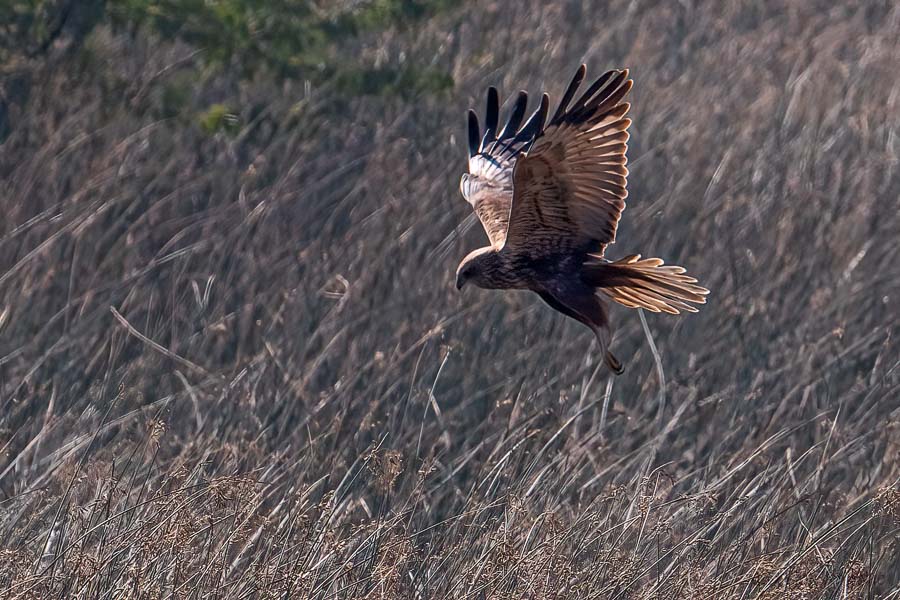
Western Marsh Harrier
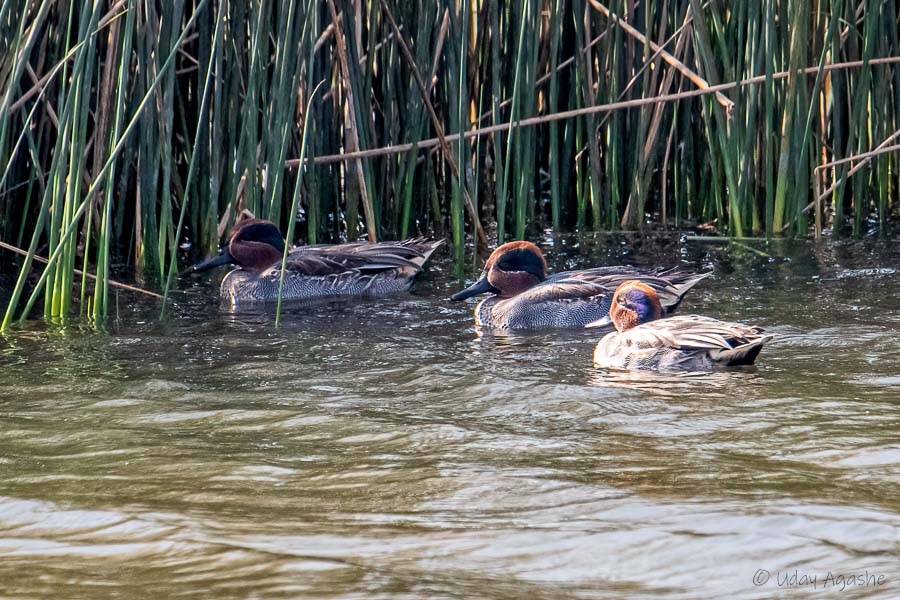
Common Teals
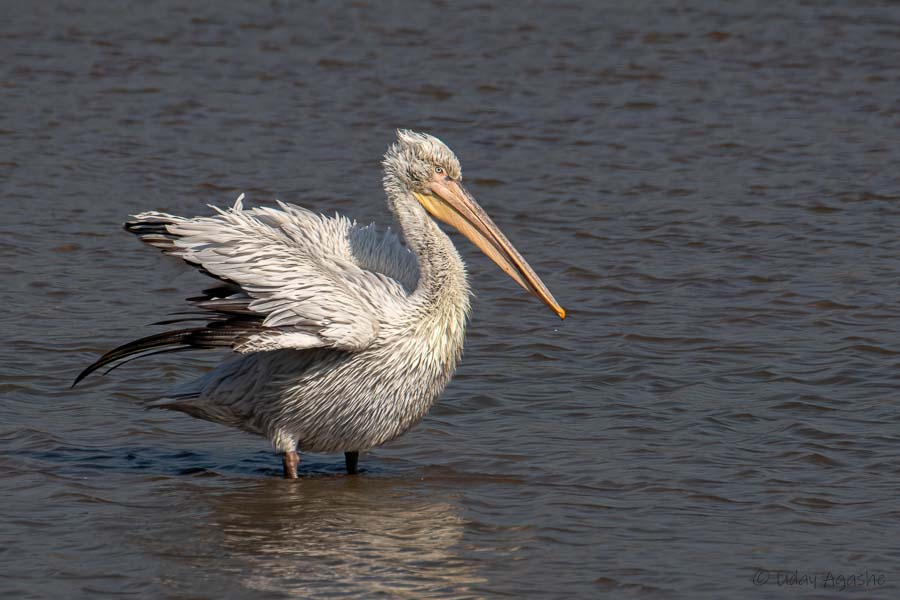
Dalmatian Pelican

Indian Paradise Flycatcher
We spent couple of hours in the park, took our group photo there and then decided to break for lunch. Although there were some other areas of park that we had not explored, our guides had other plans. They wanted to take us to a secret spot (a beach actually) where we could possibly find 2 more lifers the “Crab Plovers” and the “Oystercatchers”.
After lunch, we headed to that beach. The approach to it was also special. Our vehicles were stopped on a road suddenly (both sides there were mangrove plants) and we were asked to get down. We then followed Chetan bhai thru the mangrove bushes, within 5 odd minutes we came out into a clearing and there was the beach in front. The afternoon light was shining brightly in the waters but other than that we could see no activity there. After close examination, we could spot some bird activity far away from us.
Clara and Chetan bhai scanned the entire beach with binocs and were little disappointed as there were no Oystercatchers anywhere. But way ahead to our left, they could see a big group of “Crab Plovers”. Walking there with heavy cameras mid-afternoon in the sand, was really an effort but we hardly had a choice. If we wanted to click the Crab Plovers we better to be walking and that too, quickly (needless to say, without making much noise).
When we were at about 200-300 meters from the flock, the entire flock flew away one-by-one. As soon as Chetan bhai saw it, he instructed to us sit down wherever we were and make no movement. All of us followed and his instinct was right, after some time, the birds did come back onto the beach. It happened 2 more times in next 10 minutes but fortunately they remained. Apparently heavy movement/noise from our end would have disturned the birds and then they could then have flown away completely. Chetan bhai was aware of this, hence he guided us correctly.
While we were waiting for the flock to settle, we had an impromptu meeting to discuss our strategy (how to approach the birds without unsettling them).
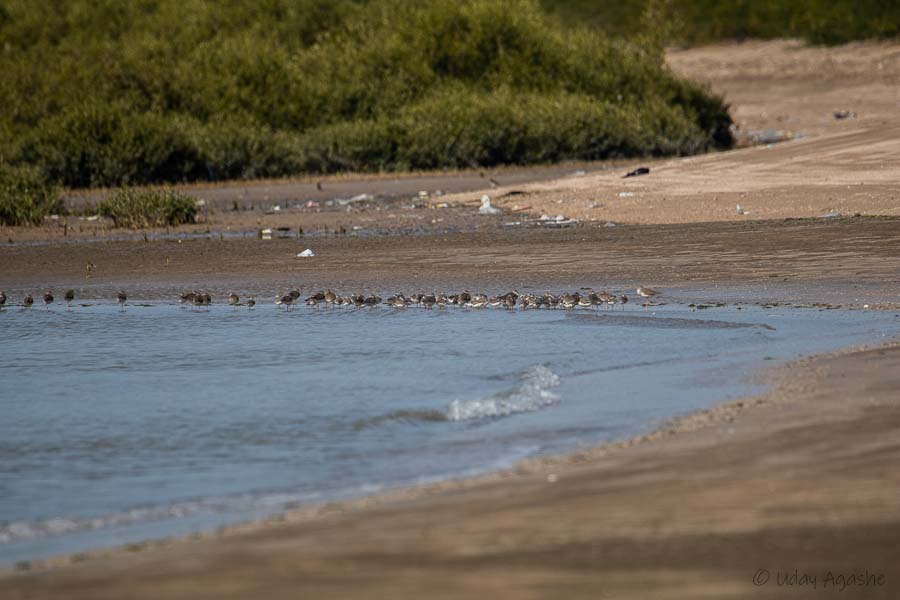
Right-hand-side view
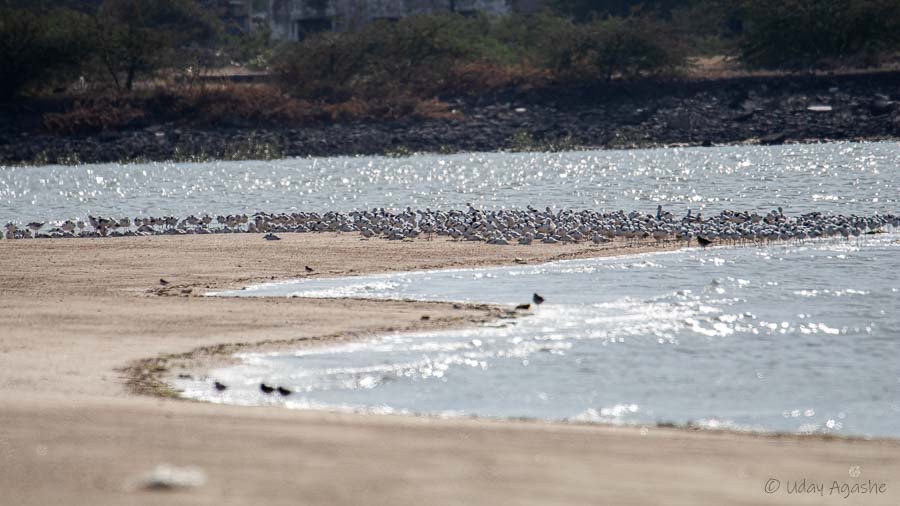
Crab Plovers at the far end
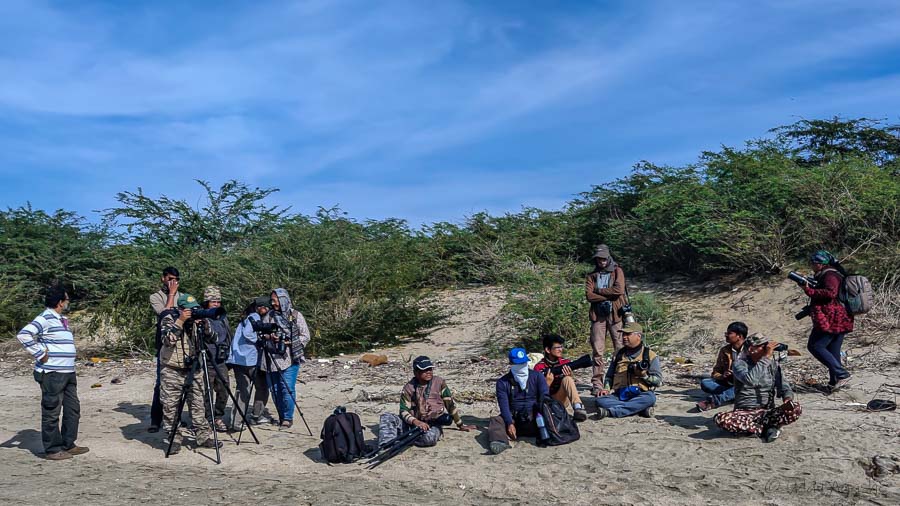
Group Discussions
It was always risky to walk straight towards them, so Chetan bhai suggested we get back into the mangroves, he knew a small path from inside that would lead us relatively closer to where the birds were at that time. So we followed him one-after-the-other in a single line for another 100 meters. He then signaled us to walk around the next set of bushes, get on our knees and then take photos. It was fascinating to watch all of us following the instructions. Some of us got on knees, some were crawling on the sand (me included) and some decided to stay back a little but stood tentatively and took photos.
We managed to take decent photos from that distance and then even attempted to walk/crawl little further, but not much. As we came into the open, the flock flew away one-by-one within seconds, none were left.
But as we were moving back to check the photos and walking leisurely, my attention was drawn to a single individual plover that kept standing just 50 meters away from us. Once again, we started approaching it. This time our crawl was lengthy and arduous (because the bird allowed the approach and did not move till we came very close to it).

Plovers in sight

Little close to the group

Some action

Solitary Crab Plover

The Crawl to get better photo
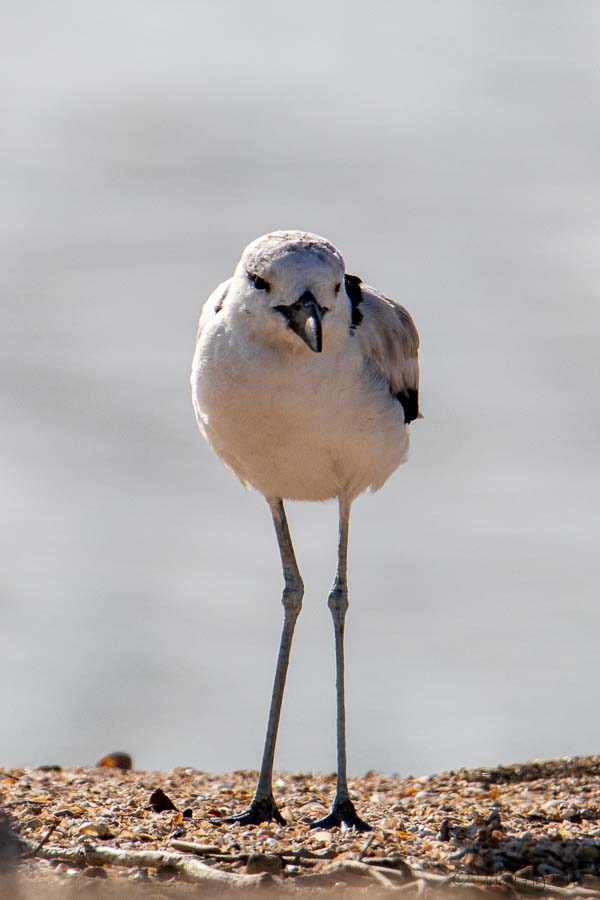
Looking into Eyes
This was done but now we again had to walk back all the way to our vehicles, there was no shortcut. Fortunately, on the way back, we could see a few more species like the “Lesser crested tern”, “Lesser and Greater Sand Plovers”, “Kentish Plovers”, etc.
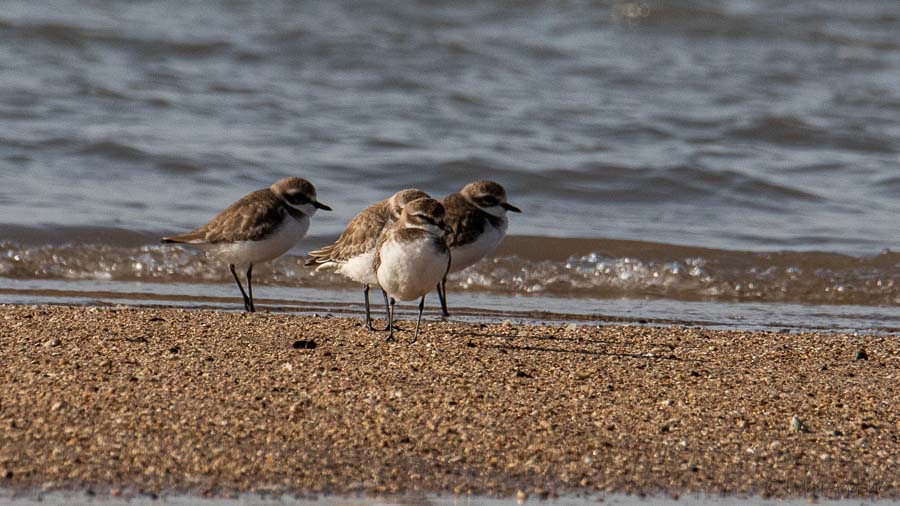
Lesser Sand Plovers
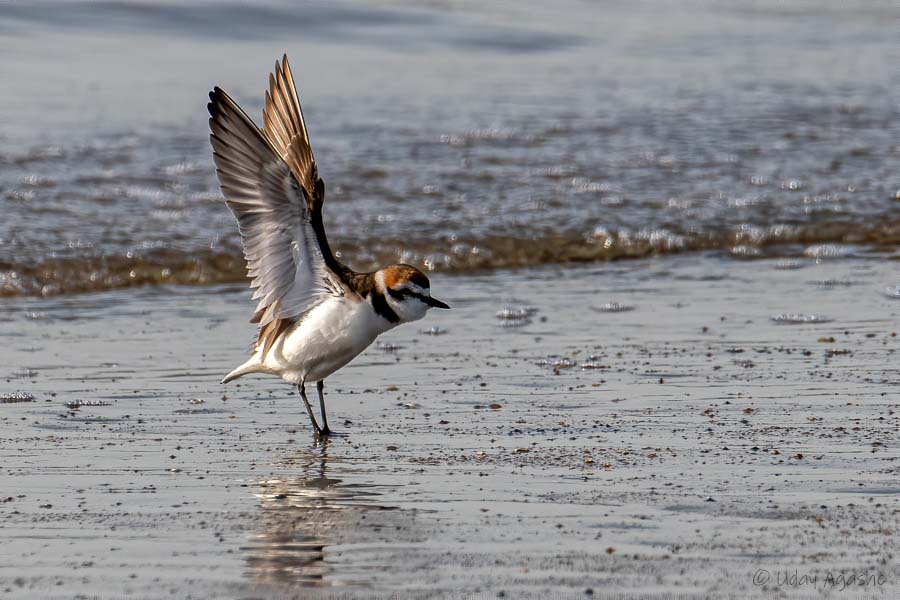
Kentish Plover
By the time we started back it was nearing 5pm but Avinash planned to take us to the “Lakhota lake” (this lake is situated well inside the Jamnagar city and seem to have a good population of migratory ducks there). But we were so tired that before reaching the lake, we had to take a tea break.
This obviously meant we reached the lake little late; the light was already fading when we entered. But there so many ducks, plus a pelican and some other water birds there. In fact, we also managed to get some nice landscape shots as the Sun was going down.
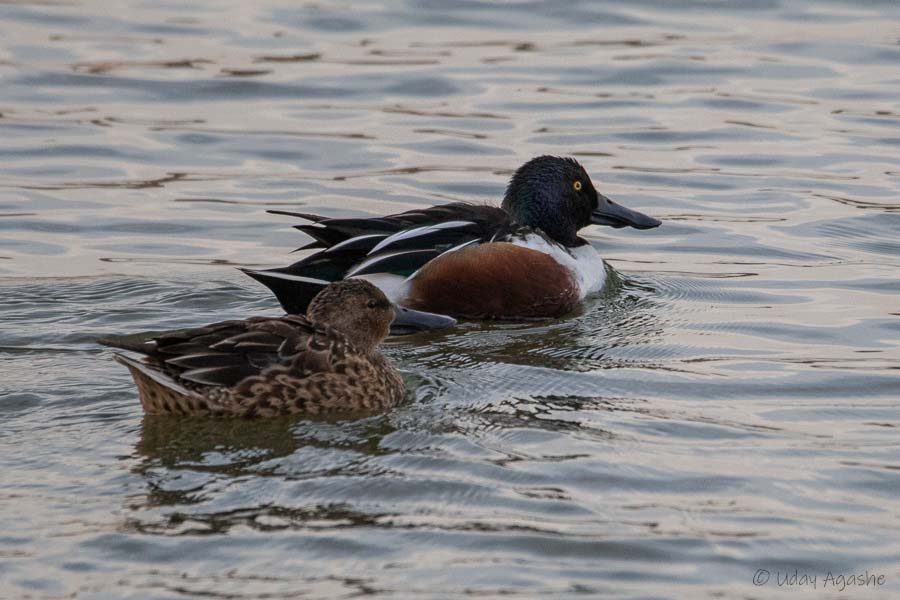
Northern Shoveler - Pair

Darter (Snake bird)
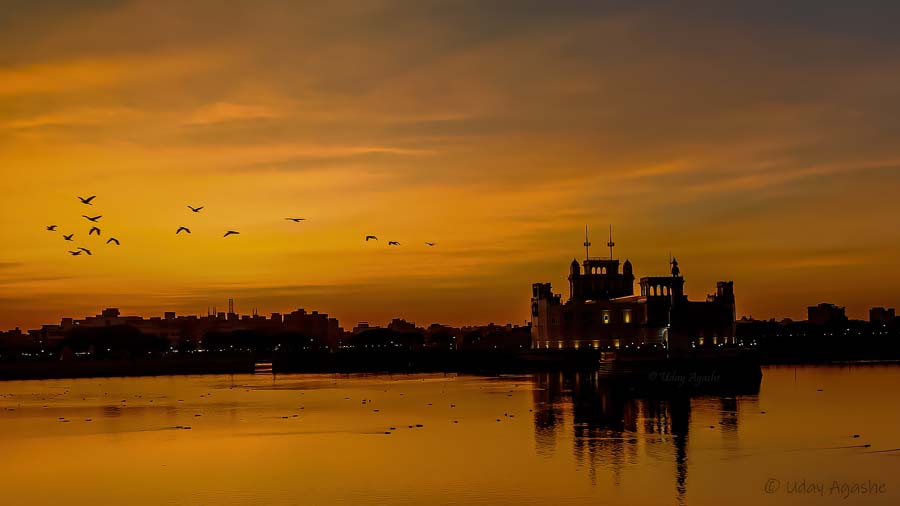
Lakhota Lake - Evening Light
As the Sun went down completely, we returned to our hotel. Dinner in the city followed by customary sighting-meeting to end the day.
But the journey back from dinner places was nice too. We had let our vehicles go by then and we all came back in the local autos. 5-6 of us could easily manage in 1 auto (2 at the back, 3 normal seats and 1 with the driver was quite normal).
Adventure in Narara
Today we planned to visit the Narara Marine National Park, some detour from the regular birding activities. Here we expected to see some of the marine biodiversity by walking in shallow waters during the low-tide period.
This place was little far-off, hence we started at 6am itself. Drove to the park by 7:15 and headed straight for the waters. It was expected to be a long walk (water was very cold when we entered it) and there was no place to rest till we were back on the beach. Avinash expected to be back in 4 hours. And we were expecting mainly to carry the Macro lens instead of the birding one. Considering this, some of us decided to stay back on the beach.
The specialty of this marine park is, the coral reef area is relatively closer to the beach and the corals can be observed by walking there (instead of the typical routine of scuba diving). The park has 4 clear zones a) mangrove forest, b) sandy beach, c) dead corals, d) the Live corals that are typical only in deep sea.
As the stretch of beach is relatively shallow, it is possible to walk a couple of kilometers inside the sea during low-tide and that is what we had planned to do. As we started walking, we also saw a few birds but the focus clearly was on the marine creatures. (Some of us, carrying the point-n-shoot camera had the flexibility of shooting birds as well as crabs/fish simultaneously).
Within first 100 odd meters, our guide stopped us to show the Mud crab. And from there on, we kept seeing some variety or other for the next couple of hours. The highlight definitely were the puffer fish and the Octopus. The Puffer fish is special because it can take-in water in large quantity and balloon itself up when feels threatened. Apparently, the fish has no known predators (besides the trick of puffing up, it is poisonous and hence the predators stay away).
We could observe various verities of the corals and also the sea anemone (these are plant like creatures that can trap their prey). There were algae and sponges also to be seen. But photographing these was difficult as they are inside water and taking a clear photo thru water was not possible.
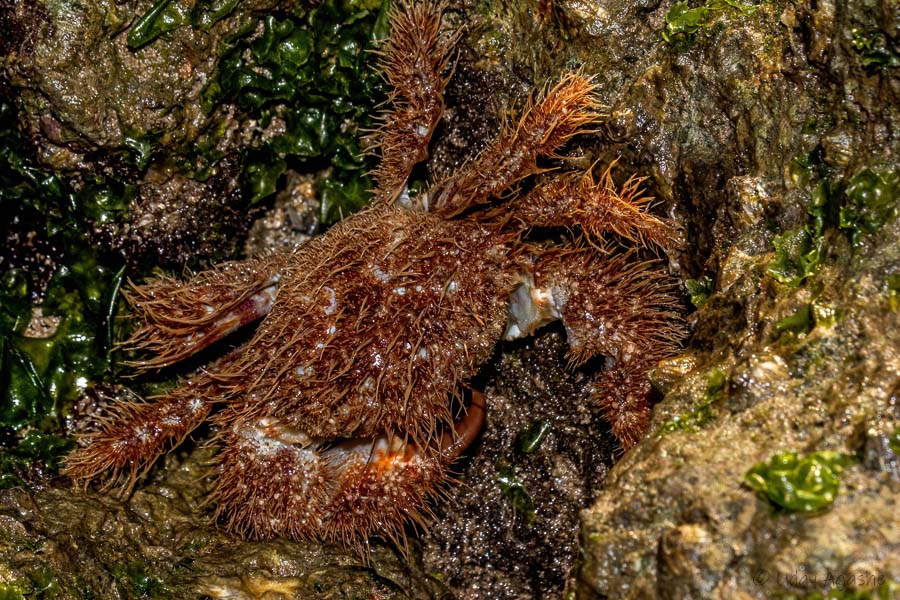
Wolf Crab
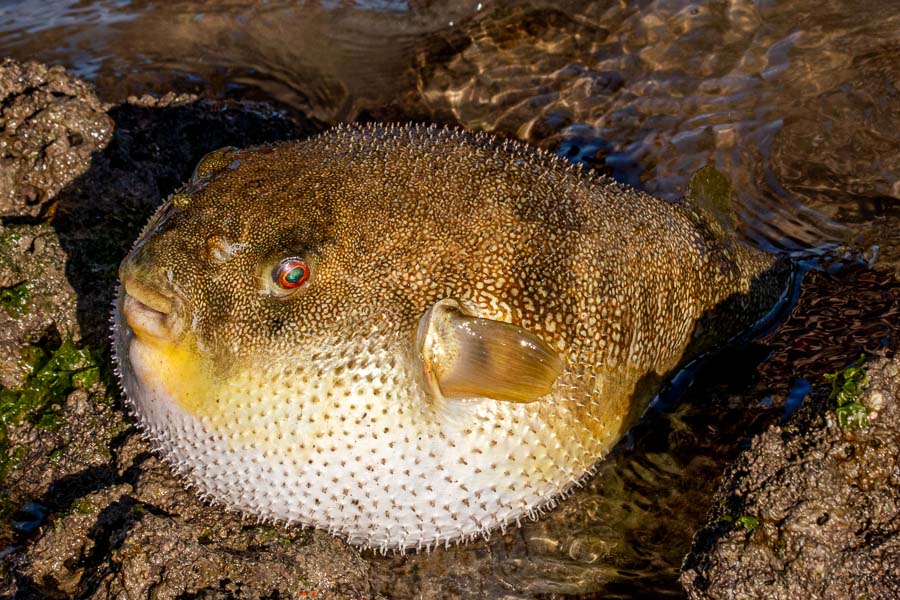
Puffer Fish
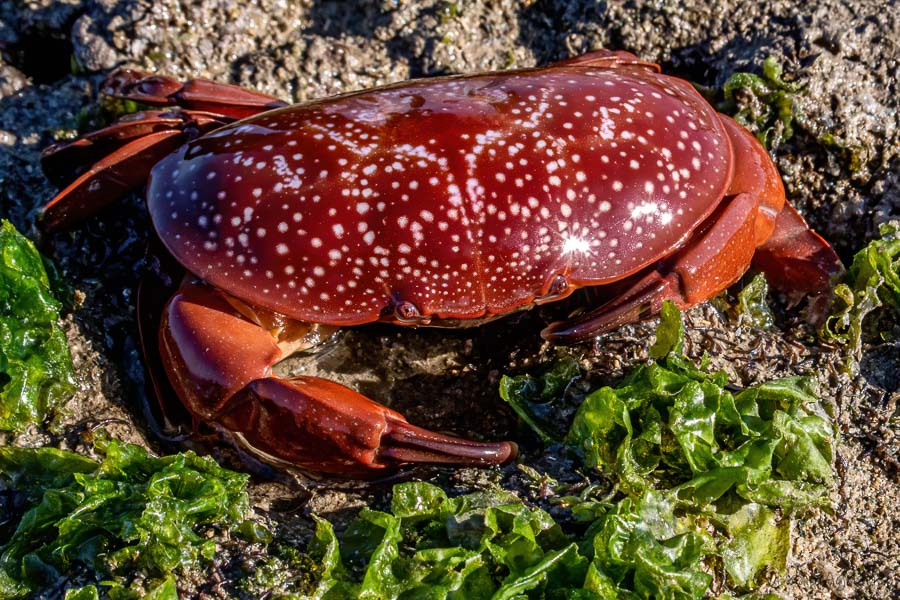
Queen's Crab
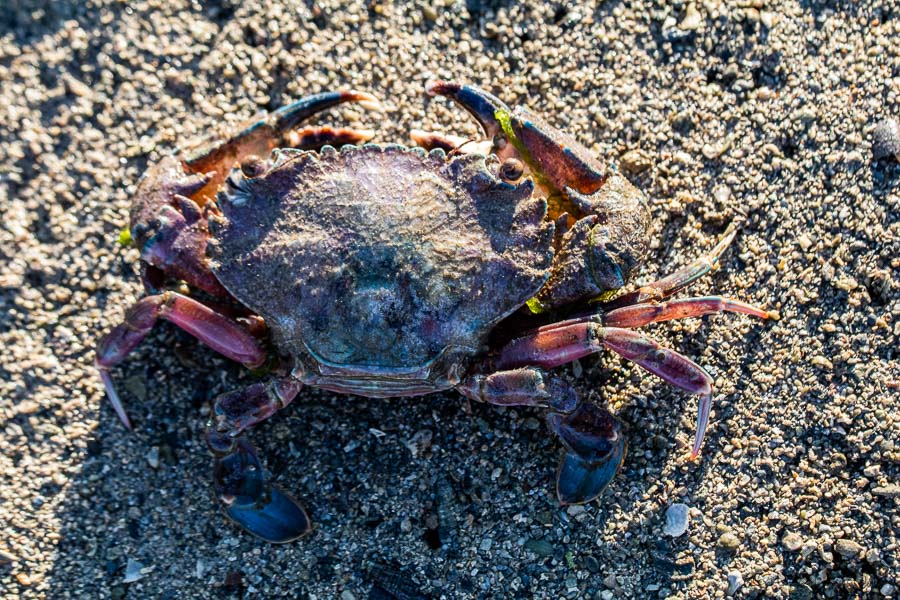
Mud Crab

Brittle Star Fish

Octopus

Typical scene in the waters
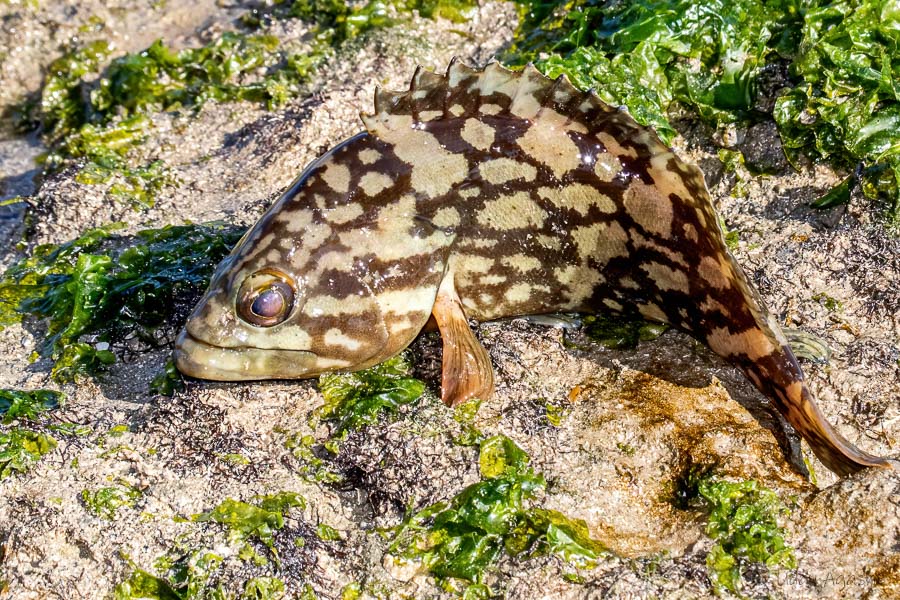
Coral Fish

Nepture Crab
While all this was happening, we did not realize how far we had walked. It is only when our guides asked us to start the return journey that we looked back at the beach. That back journey was very tiring (especially on empty stomachs as we thought of having breakfast after this trail).
After reaching back, we wasted no time and quickly consumed the available breakfast. The tea tasted sweeter than normal. Our friends who had stayed back also managed to get some very good bird images from the beach.
Although the marine diversity was good, we had again missed out on one target bird specie, the “Oystercatcher”. It was then decided that we will come back again to the beach near high tide. Normally during high tide, the birds try to move near the shores and hence the likelihood of sighting them is better.
And so we had some spare time, we decided to explore the nearby water bodies (we had earmarked them earlier while coming to the beach). And our exploration was immediately fruitful. We found a rarity, the “Black necked Grebe”. Once again, we would have completely ignored the sighting if Avinash would not have been with us. Even the local guides were not aware. Luckily Avinash felt that the ducks looked little different and he got down from the vehicle. Guys in his vehicle had the advantage of clicking them from relatively close distance (the moment we get down from the vehicle, the ducks will start to swim away.. hence by the time we got down, they were already far).
We could see the usual flamingos, pelicans, gulls and terns in good number. So next half hour went into clicking them on both sides of the road.
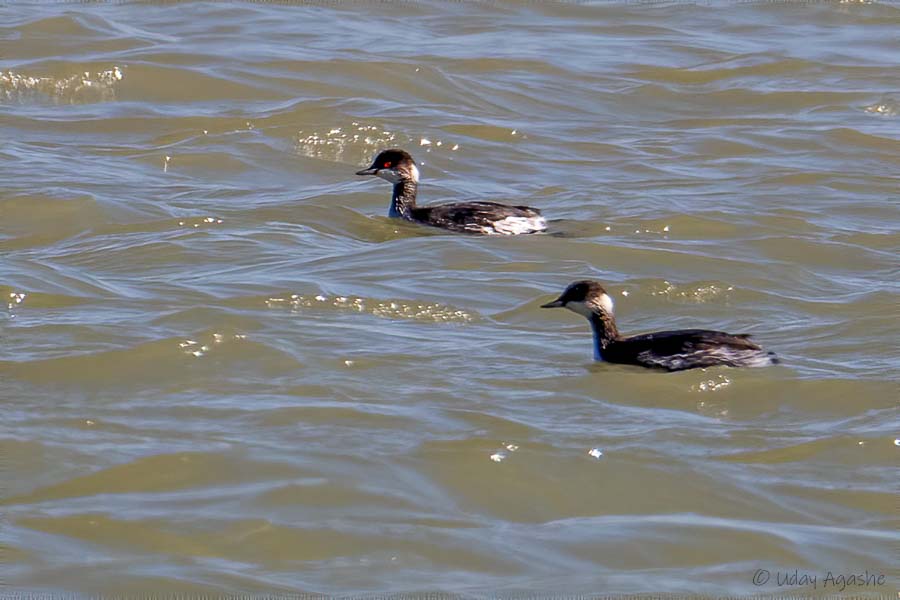
Black-necked Grebe
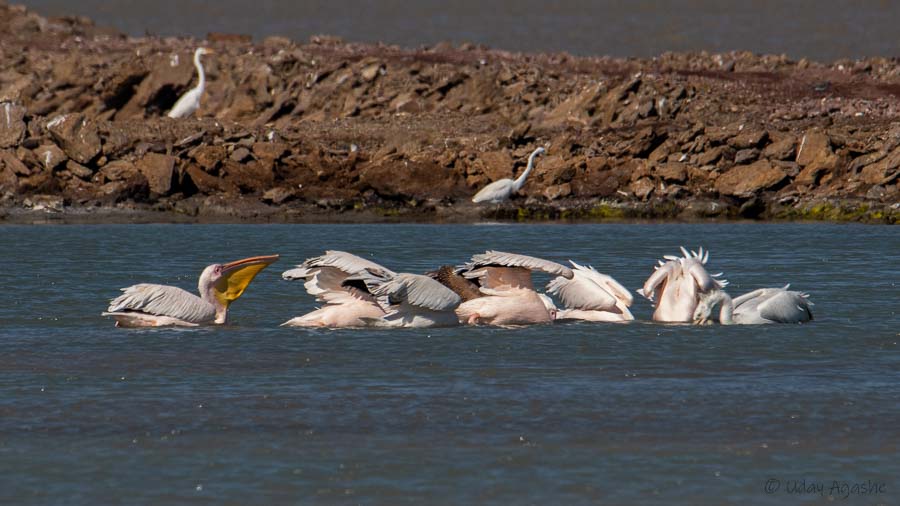
Rosy Pelicans
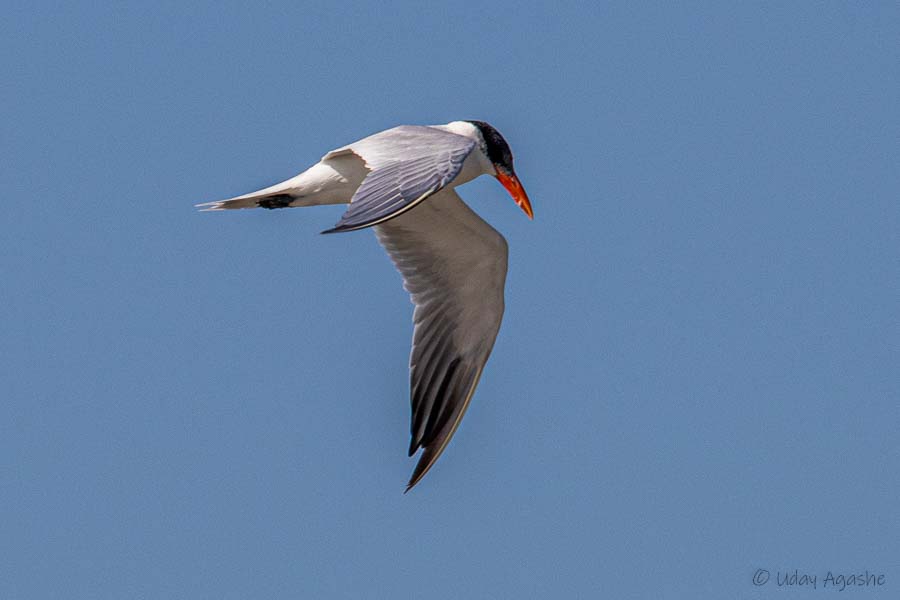
Caspian Tern
At around 2:20, suddenly Avinash asked us to quickly get back into vehicles. He expected the sea water to rise and that was our only chance to catch the Oystercatchers. We quickly reached the beach and to our surprise, water was right there at the starting point (it was at least 2 kms inside when we came in the morning). And there appeared to be no way to go thru it in search of the birds. That is where the adventure began.
Chetan bhai then told us to follow him thru the waters (close to knee level). I just could not understand where he was going, but he said we will walk thru the mangroves to the other side where there is small patch of land that is little at height and the birds are likely to be occupying it. While he was saying this, we saw a bird flying from that direction and immediately Clara exclaimed “Oystercatcher!”.. that glimpse increased our confidence and we decided to wade the waters
One by one we followed Chetan bhai, carefully handling/balancing the tripod & camera along. The water was rising slowly and we could definitely feel the pressure. Few steps ahead, suddenly the guys in front took a left turn (piercing the mangroves) and were not to be seen. Luckily they called us out and we followed.. next few steps we were just maneuvering thru the mangroves (in the water).. after about 20 meters, we emerged on the other side and Chetan bhai again asked us to stop. Here we were asked to be careful (so as not to alert the birds) and try to remain hidden behind the mangrove bushes.
The moment we saw the target, all our cameras were in action.. I had carried tripod but could not risk putting it in the water, so I carried camera+tripod together and started taking photos in that awkward position. We barely got 5 odd minutes there and the guides immediately asked us to walk back. They wanted us to return back to safety (the tide was still increasing and with more water, going back on the beach would have been riskier). Once again, we started moving in a line, the water levels were definitely higher but still manageable. Gradually we were back on the sand.
The photo quality wasn’t good but the feeling of achieving the target was more than satisfactory.

Oystercatchers as we first saw it

Oystercatchers, Lesser Crested Tern & others
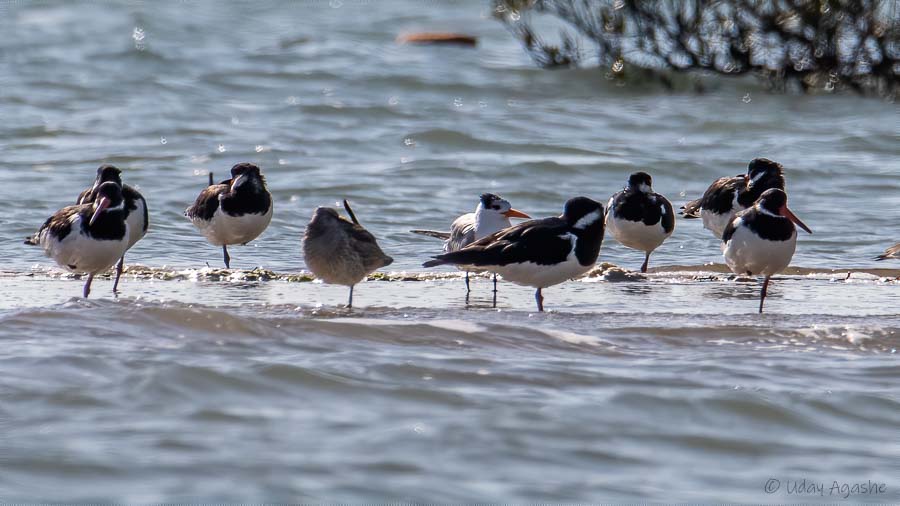
Increased water level within couple of minutes
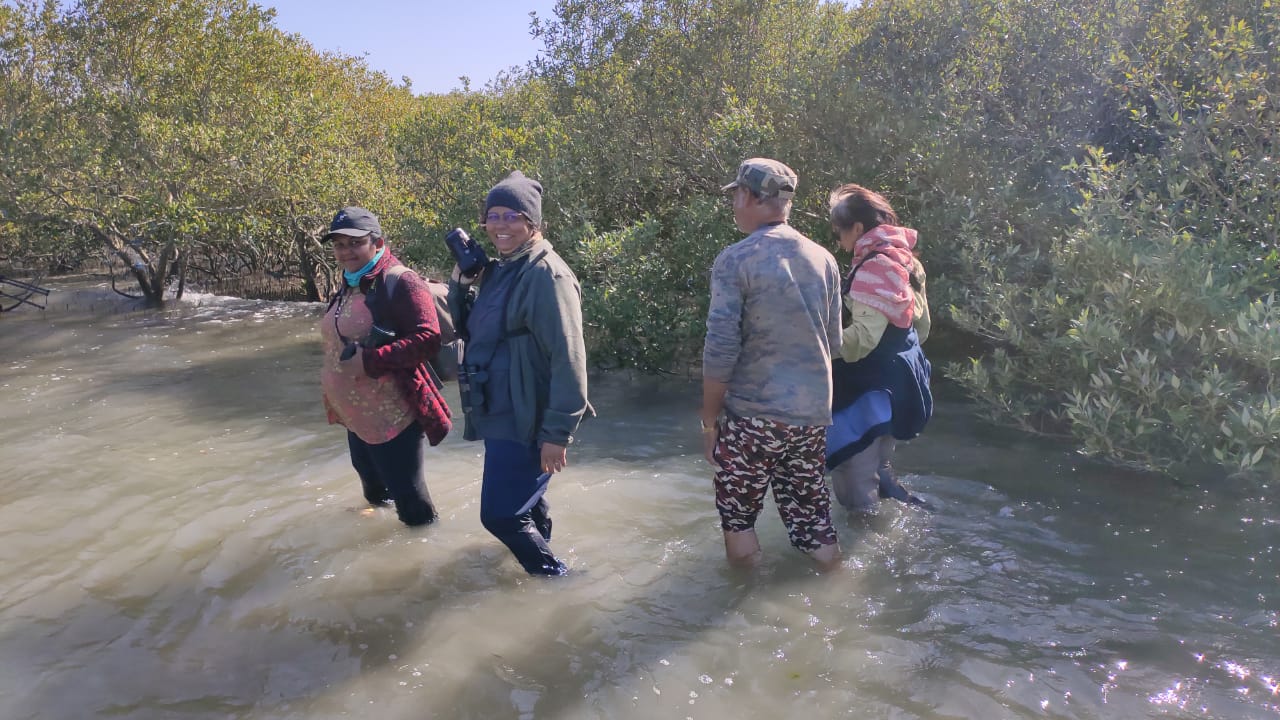
Wading the waters..
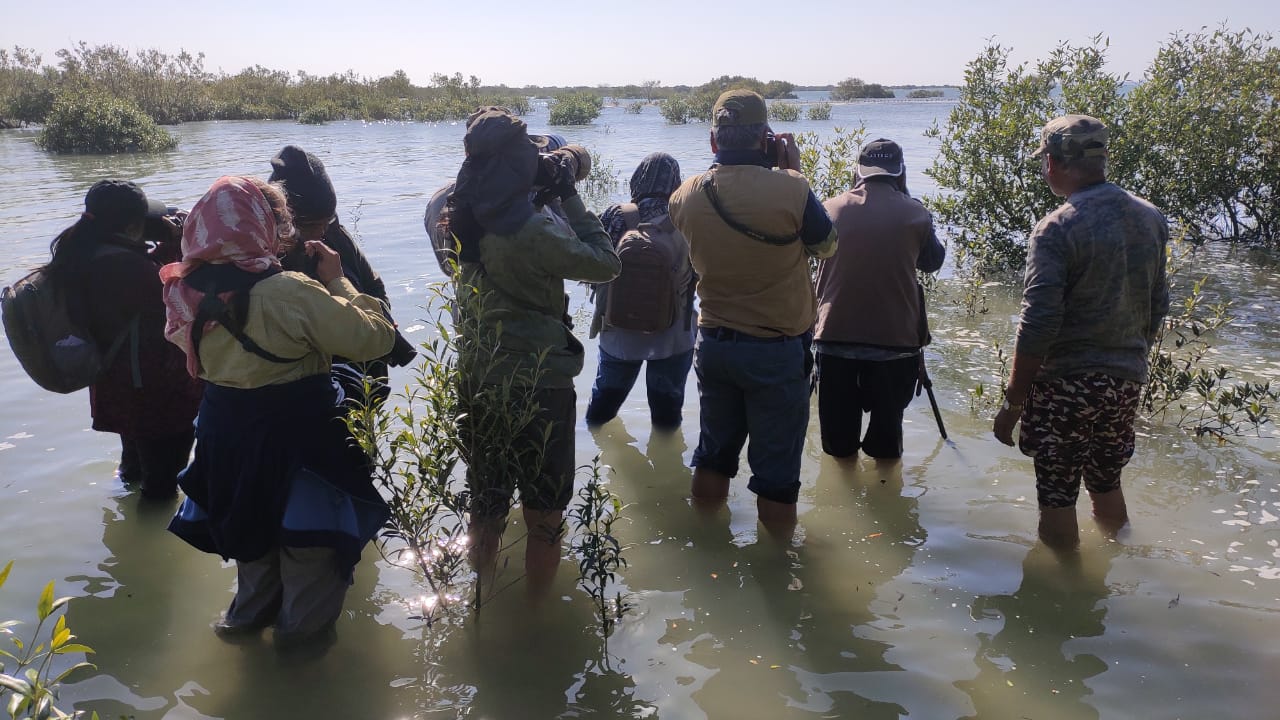
Just get some record shots...
This adventure and the long walk in the morning meant we were all really tired. There was no energy left for any further birding and on top of that, we were yet to have our lunch. On the way back, we had lunch at a restaurant on the highway and got back to rooms for some well-earned rest. I was actually little feverish and took a crocin as well.
After couple of hours of rest, we got down for dinner and the subsequent meeting. Today Avinash gave a small powerpoint presentation on the species we covered earlier in the day and shared information about the bird identification aspects.
Last day of the tour
This morning our plan was only to cover the Lakhota lake that we had briefly seen on Day 2. At that time, we hardly had any light for photopgraphy and hence we planned to visit the lake again. We had time for birding till 11am, pack our bags and check-out by noon. (our train was at 2pm).
We reached the lake before 8am and got on with the job. Today, the light was definitely better than the earlier evening and most of the duck species were swimming close by. The pelican was missing though.
We spent an hour there and then took a quick breakfast break. Got to a roadside eatery nearby and once again satisfied our taste buds with the local delicacies (followed by tea of course).
Back to the lake, for some more ducks, Great cormorant and the Darter bird. After that we diverted our attention to the myriad gulls that were flying near the road (as many in numbers as the pigeons in our cities).
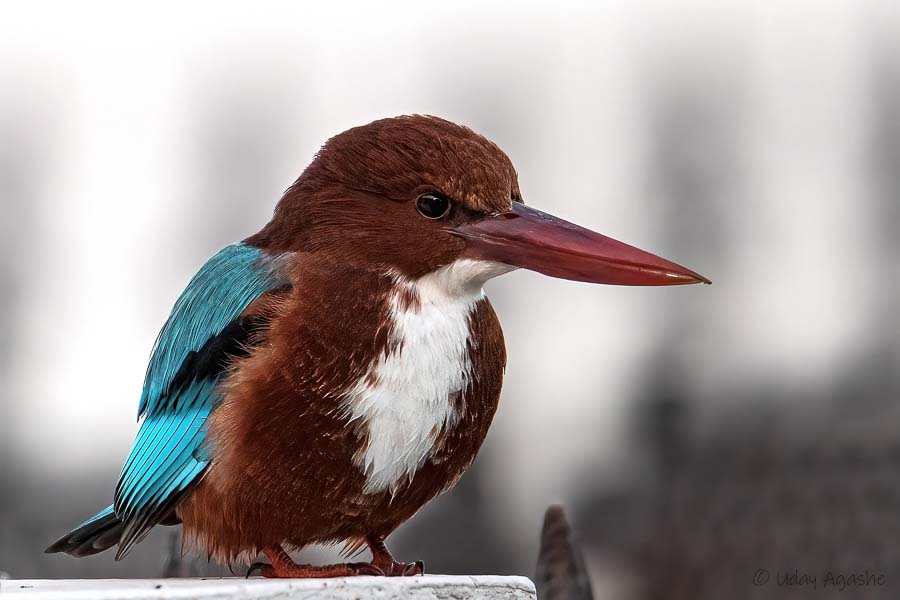
White-throated Kingfisher

Ferruginous Pochard
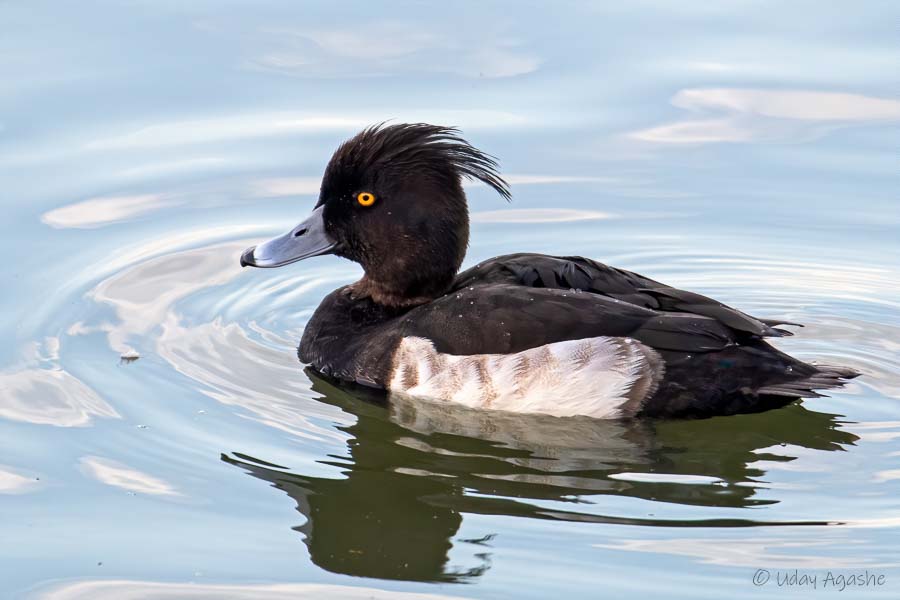
Tufted Duck
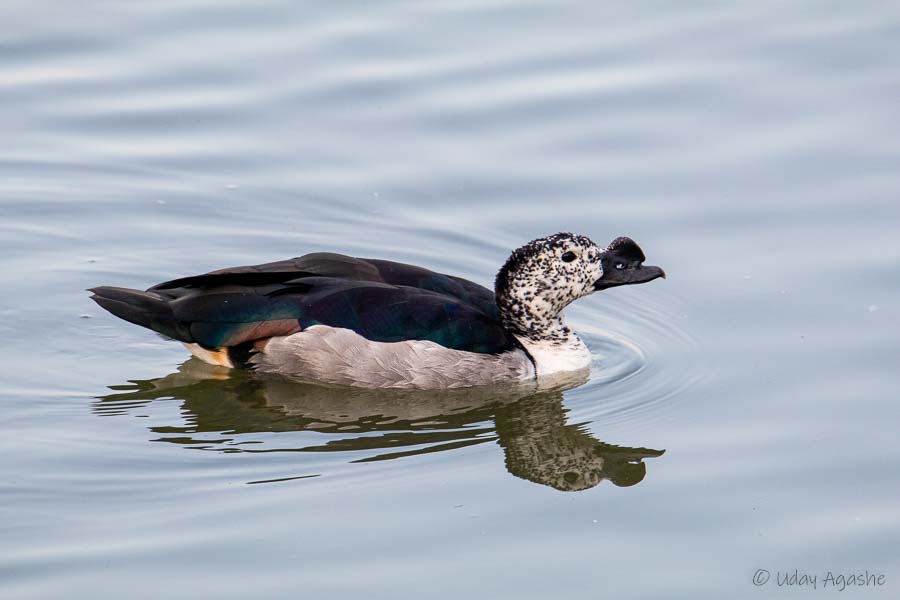
Comb Duck
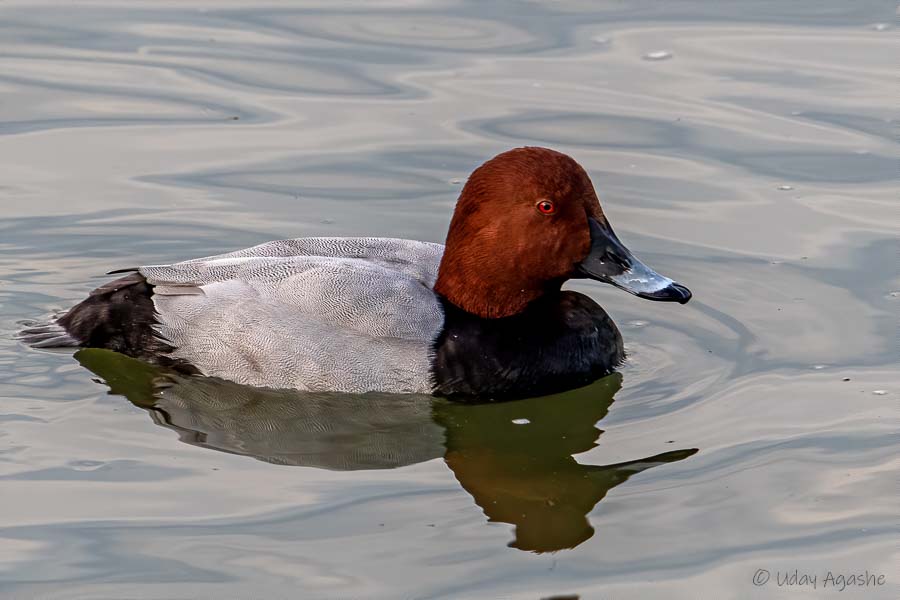
Common Pochard
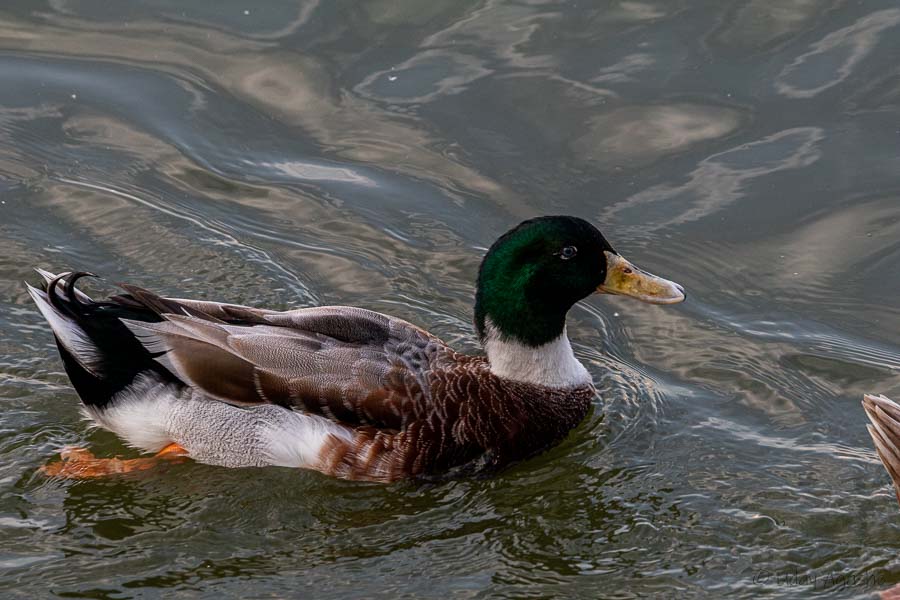
Mallard Duck
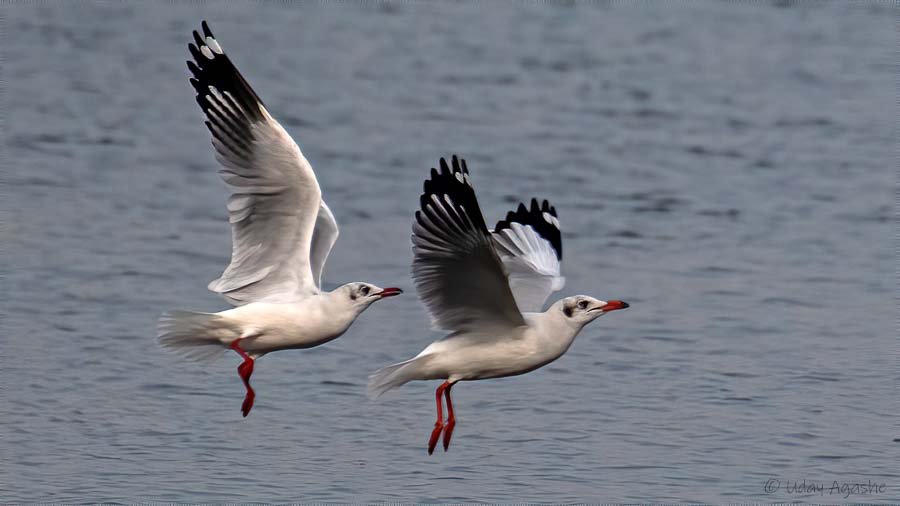
Brown-headed Gulls
We were well within our schedule and reached hotel rooms before 11am. Quick shower + bag-packing and we were out of the hotel by noon. Now we just had to have lunch and then head for the train.
Train journey was the boring (total 15+ hours of journey time) part but we had the successful trip memories to carry. Luckily 4 of us were together in one coach and the discussions continued till night.
Reached Mumbai in the early hours and then the road journey home was peaceful (no traffic at that time of the day.. 5am).
That was the end of yet another fantastic trip with JungleHike. Super sightings and unmatched company made the trip a roaring success for me. Got more than 10 lifers in the 4 days.
I will be more than happy to answer any query about this tour. You can either put a comment down here or write to me on “uday.agashe@gmail.com”.